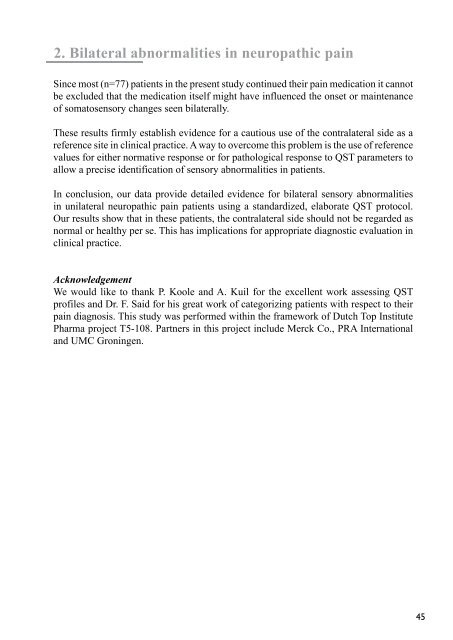Quantitative Sensory Testing (QST) - Does assessing ... - TI Pharma
Quantitative Sensory Testing (QST) - Does assessing ... - TI Pharma
Quantitative Sensory Testing (QST) - Does assessing ... - TI Pharma
Create successful ePaper yourself
Turn your PDF publications into a flip-book with our unique Google optimized e-Paper software.
2. Bilateral abnormalities in neuropathic pain<br />
Since most (n=77) patients in the present study continued their pain medication it cannot<br />
be excluded that the medication itself might have influenced the onset or maintenance<br />
of somatosensory changes seen bilaterally.<br />
These results firmly establish evidence for a cautious use of the contralateral side as a<br />
reference site in clinical practice. A way to overcome this problem is the use of reference<br />
values for either normative response or for pathological response to <strong>QST</strong> parameters to<br />
allow a precise identification of sensory abnormalities in patients.<br />
In conclusion, our data provide detailed evidence for bilateral sensory abnormalities<br />
in unilateral neuropathic pain patients using a standardized, elaborate <strong>QST</strong> protocol.<br />
Our results show that in these patients, the contralateral side should not be regarded as<br />
normal or healthy per se. This has implications for appropriate diagnostic evaluation in<br />
clinical practice.<br />
Acknowledgement<br />
We would like to thank P. Koole and A. Kuil for the excellent work <strong>assessing</strong> <strong>QST</strong><br />
profiles and Dr. F. Said for his great work of categorizing patients with respect to their<br />
pain diagnosis. This study was performed within the framework of Dutch Top Institute<br />
<strong>Pharma</strong> project T5-108. Partners in this project include Merck Co., PRA International<br />
and UMC Groningen.













